Observations of Canada during 2013 trip
Copyright 2013 John T. Reed
I have visited Canada now five times, most recently, for two weeks—my longest visit.
Canada’s man-made structures generally seem to be better maintained or newer than ours. I am mainly talking about stores. Roughly speaking, it appears that the US chains that are also in Canada have newer, shinier, cleaner stores in Canada. For example, 7-11s, which are generally ratty and dirty in the US, in my experience look like the flagship, company-owned showplace in my limited experience in Canada.
During my two-week trip to Canada, I spent a few days in Northwest, WA. The Bellingham Walmart was itself not so bad, but the customers were ratty. Then I went to some Walmarts in Canada. You gotta be kidding me! They were like brand new hospitals—super sparkling clean. One was in the Lougheed Mall, a really nice mall with Canada’s top department store—the Bay Company—and all the other fancy shops you would expect in a top mall. As far as I know, no US owner of such a high-tone mall would even consider letting a Walmart be a tenant there. The McDonalds are on average nicer. In many ways, Canada seemed like the US, only newer and nicer and cleaner. I do not know why.
Their prices were generally a bit higher so maybe you get what you pay for.
Nicer, better looking
As a group, the Canadians are much nicer people than Americans. More polite, helpful, friendlier, nicer dressed. The Calgarians were better looking on average than Americans. On a recent trip to Chicago I commented that California girls were better looking than the typical Chicago girl. They were reminiscent of the “Dark Lady” in Cher’s song. Cher is of Armenian descent. Both the men and women in Chicago seemed eastern European to me—to be cast as fortune tellers or Russian mob in movies.
The Calgarians, who also seemed better looking than the Vancouverites, do not all look like movie stars as people often say of LA cops and I would say about UCLA students. But the average Calgarian is better looking than the average American.
It also felt like I had gone back in time. the percentage of Caucasians was like my college years in the 1960s.
Calgary Stampede
My wife and I went to Calgary for the Calgary Stampede, which I highly recommend. They ask that you dress up like a cowboy or cowgirl when you go.
I normally wear Wrangler jeans—a sponsor of the Stampede. I have not owned cowboy boots since I was about 5, but I had some hiking boots I bought for my 2011 Grand Canyon backpacking trip and wore those to the Stampede, mainly to deal with the wet ground and dirt and dust. I also wore a Filson pullover western shirt that I wear in the winter here in California. And I had a straw cowboy hat in the coat closet that I got for a father-son cowboy theme night when my kids were in elementary school or some such. Except for the boots, I fit right in.
I am a Californian, for most of my life, although I am still surprised every time I say that. We are actually a bit western here without really thinking about it. Almost every time I go anywhere in my car, I see cattle grazing. Little doggie beef cattle, not dairy cows.
Almost as often, I see horses grazing or in corrals. We also see deer and coyotes and hawks and all that. I live on the side of Mt. Diablo, one of the main survey markers in the west. The words canyon, stage line, gold country, and arroyo, and all that are used here un-selfconsciously—remnants of our cowboy past. Our San Francisco NFL team is named after the California gold rush prospectors. At the main intersection of our little settlement of Alamo, there is a full size statue of a horse on the roof of the feed and grain store and they really sell feed and grain. The shoemaker there also repairs saddles and bridles.
Cowboy clothes
The Calgarians appear to be the same if not more western. The whole town was dressed cowboy style—men and women. If you did that here, even in a town that claims to be cowboy like Dallas, I expect a large percentage of the people would look ridiculous—like that Florida Congresswoman who was wearing a pink cowgirl outfit when she denounced George Zimmerman. Not in Calgary. I think you could have taken the whole bunch of them as is and made them extras in a cowboy movie without much culling out or re-costuming. You would have to remove the old Chinese women who did not know how to wear a cowboy hat. Some had them on backwards; one, sideways. The V-shaped part points forward. The label and seam go in the back. I’ll give these women half credit for trying—albeit slightly—to assimilate.
Then there were the Indian couples as in Hindu, not Native American or First Nation as they are called in Canada. A typical Southwest Asian couple would have the wife in a traditional sari dress as for Mumbai while her husband was dressed head-to-toe in cowboy stuff. They are not going to get work an extras in a cowboy movie because of their complexion—except maybe as a North American Indian—but their clothes were as authentic and unaffected as the native Calgarians’.
I saw no rhinestone cowboys. Not much fringe except on the ladies at the elegant soirées. There were many huge belt buckles. Not sue what that’s about but one of the brand names of them is Attitude. There was an old movie poster of John Wayne wearing his famous western shirt with the square plaquette buttoned on to the front at the Stampede. Here are some models wearing that style. And here is John Wayne himself wearing a different shaped one. No one, I repeat, no one, at the Calgary Stampede wore that shirt or any facsimile of it. Apparently they know and agree with what the Hollywood elite would say about wearing it.
It’s been worn.
In other words, when the Calgarians decide to wear cowboy clothes, they just select from a different part of their closet. They do not need to go to the attic or the costume shop. Their cowboy clothes are unaffected and authentic, not silver spurs and all that kind of stuff. The rodeo competitors could generally walk around the Stampede in their competition outfits and not be noticed because of the way they were dressed—although their age and athletic builds would likely give them away. And Calgarians have the basic faces and body shapes to match extras in a cowboy movie. If there is an obesity epidemic in Calgary, it was harder to spot than ours.
Here is a photo of me and my Harvard Business School sectionmate host at the President’s reception. He is an oil company executive in Calgary—says he does not understand why environmentalists are anti-oil: “It’s all natural, vegan, organic. I thought they liked that stuff.” His unseen left arm is around the shoulder of my “No publicity for me thank you” wife.
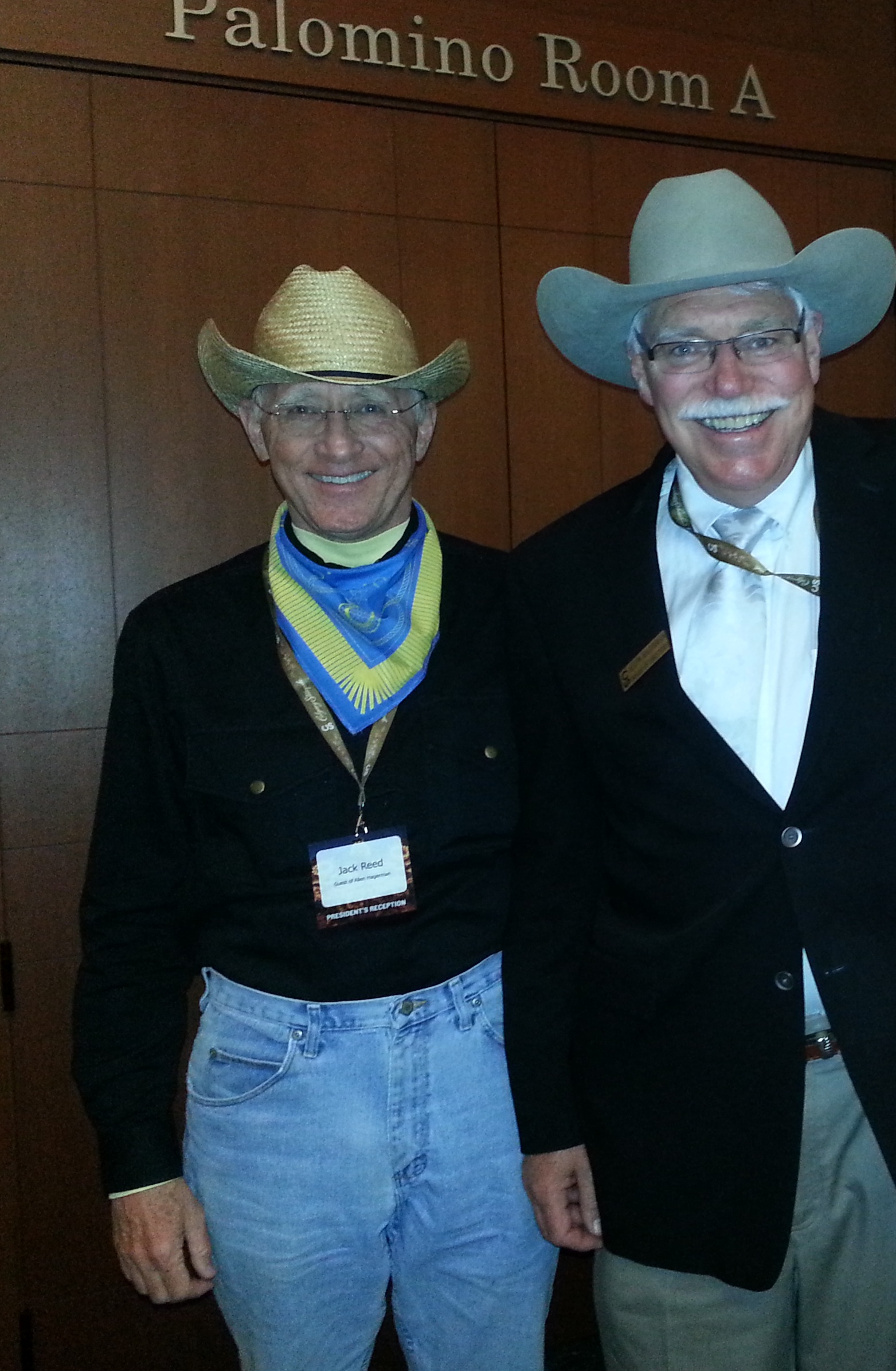
Always help nearby
Whenever I got bewildered in either Vancouver or Calgary, someone would ask if they could help me. About 2/3 of the time, they were paid to do that; the other 1/3, just ordinary Canadians. For example, I bought a Coke Zero from a machine at the Stampede. I was leery of it and had to fish out the $3.00 CAD to pay for it. That denomination means a $2 coin and a $1 coin. There are no bills smaller than $5. I did not have the coins so I put in a $5 worried I was going to lose it. As I fished out my Coke and the change and started to count it, a woman wearing the Stampede official employee shirt asked if I got the right change. Yes. Her job was to watch that machine to make sure it gave the right change because they had some bad reports about it. I talked to her for a while Her daughter had competed twice in the Olympics for Canada in the breaststroke, then went to the U. of MN to the consternation of the Canadians.
In Vancouver, I got on the subway and thought, “Uh oh, I think I’m in the wrong one.” A guy who works there to make sure everyone is okay asked if he could help. I was indeed in the wrong station and needed to take the oncoming train to the next station where I could transfer to the right one. He then found another group in the same predicament and told them to follow me. In Calgary, waiting for the light rail, a citizen saw our faces and asked where we were going. To the Stampede. There were two kinds of trains going by there. One went north not to the Stampede; the other south to the Stampede. She told us to wait for the one with the name of the town at the end of the southern line.
I have also been helped like this in Chicago, Boston, San Francisco, New York—but less consistently and not as often as in Canada. In Chicago in April, a black guy on the El station saw our bewilderment once and helped us—although he was mistaken about what we needed to do—appreciated his effort though. And we saw an old black woman having trouble at the station next to our hotel and explained to her how it worked. In Chicago, Boston, or New York, the help you get is like out of a movie scene with a character actor. “Wrigley? Yeah. Just keep goin’ the way you’re goin’. Ya can’t miss it.” Or the subway to JFK. “Dey ain’t no train to de airport on Sunday. Take de A train—Ozone or Far Rockaway—don’t matter on Sunday—get off at Rockaway Boulevard. Dey have a bus dere on Sundays to take you to Howard Beach—de JFK subway stop. Okay?”
Yo!
My Harvard sectionmate got us into a bunch of special events—the [Calgary Stampede] President’s breakfast and the VIP section of the parade viewing stands for example. My friend could not accompany us because he was IN the parade riding a horse as a director of the Stampede. With difficulty, we found the breakfast—or I should say an unlocked door in the vast building where it was held. But as the breakfast broke up, we were unsure where the VIP section of the parade viewing stands was. A man whom I recognized as one of the big shots who had addressed the room during the breakfast asked if we needed any help. I said we did and he walked us to the VIP stands.
If you are on the lam and do not want to be noticed in Calgary, never look bewildered. If you do, people will help you. This is less true in Vancouver, but probably more true in Vancouver than in the US.
Stampede parade
The Stampede parade was interesting. I marched in a whole lot of parades at West Point so I guess I am a reluctant parade connoisseur to an extent.
Canadians march differently—military, police, fire, bands, drill teams. They swing their arms forward up to parallel to the ground. It looks pretty dorky to an American’s eyes. Also, few reached the parallel altitude so it looked a little sloppy because of not being uniform. Here are Royal Canadian Mounted Police doing it.
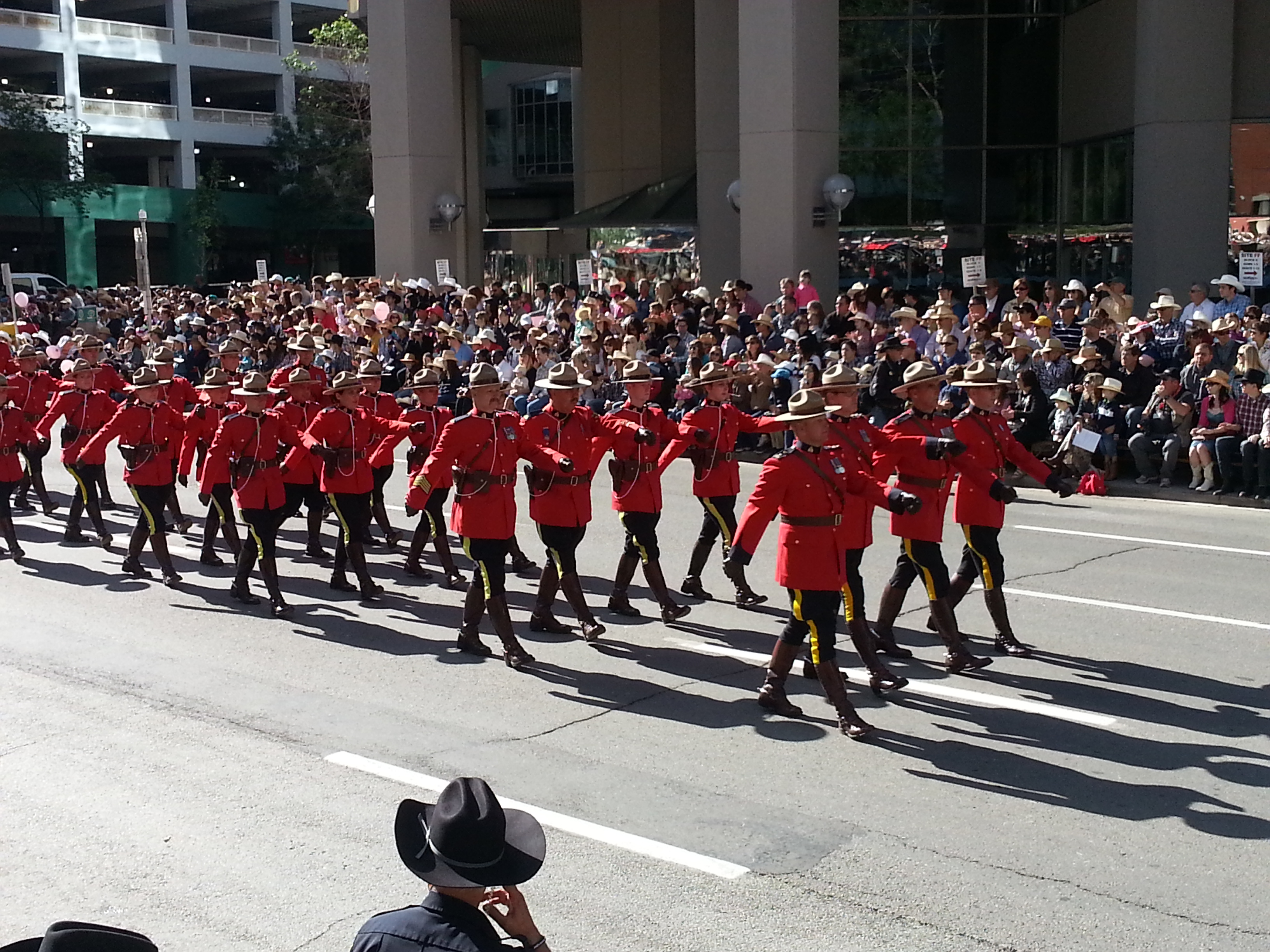
Some units also did some sort of mincing steps They seemed to be trying to put their entire foot down on the ground simultaneously. That required shorter steps.
At West Point, we were taught to swing our arms 9 inches to the front and six to the rear, take 30-inch steps, and land on the heel of the front foot. We were to cup our hand with the thumb pointing at the ground and not break our arm at the elbow when we swung it, although we were not to lock the elbow stiffly. All of that is about as close to normal walking as you can get. That has the virtue of increased compliance with the specified movements compared to the Canadian style where it is apparently hard to get everyone to swing the arm correctly. Why the precision like how many inches to swing the arm? To complement the uniformity of our uniforms and being in step. The original idea of marching was battle formations where the the uniformity in all respects including movement tended to make the unit look like some sort of huge advancing monster.
Here is a photo of an unexpected delight. Calgary street sweepers were part of the parade—sweeping up horse poop—but they dressed almost all of the street sweepers up in animal costumes. Here’s one with a bull’s head, back (sort of) and tail. Note also the almost universal wearing of cowboy clothes in the crowd.
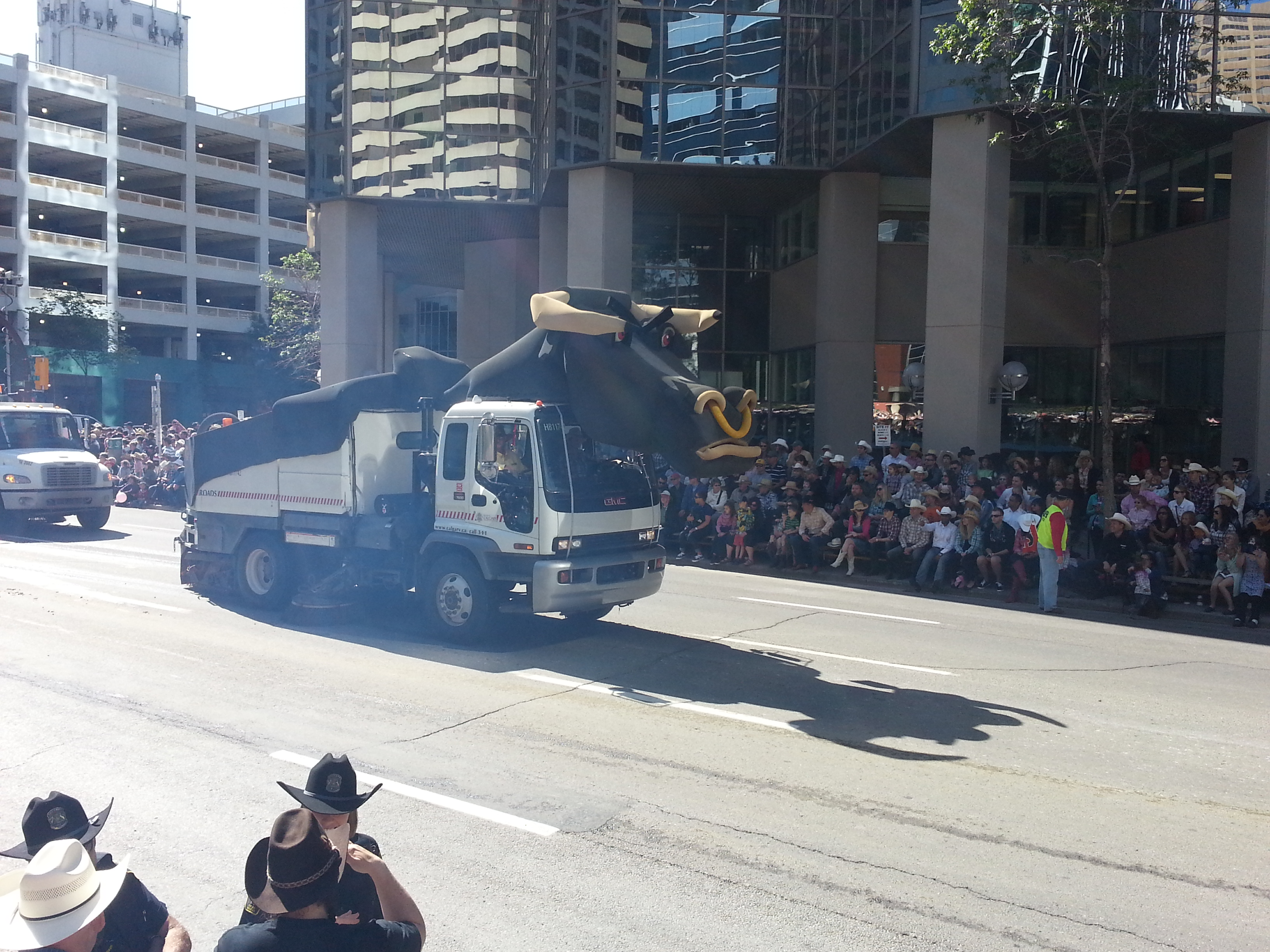
I have written on other occasions that I was annoyed with Canadians frequently setting themselves apart from Americans by displaying Canadian flags everywhere. At the parade, we saw the no Americans around Canadian pride and it was heartwarming. I have no objection to Canadians being proud of the accomplishments of their people or of their land. I am only bothered by Canadians being proud of not being American. That, which is often in evidence outside of Canada, seemed absent from the Stampede parade in Calgary—which is 125 miles north of the US border.
Flood
There was also an extra measure of pride in this particular Stampede parade. 2013 was the 101st Stampede. “Second century” they were fond of calling it. But Stampede 2013 was even more noteworthy because of the flood.
After the four days of Stampede, we went to Banff National Park and stayed at Lake Louise there. Banff and Calgary share a river: the Bow. It starts in the Canadian Rockies which in Banff is a land of snowcapped mountains (even in July) and glaciers.
The 10-day 2013 Stampede started on July 5th. On June 20, the Bow flooded—big time. Here are some pictures of the flood at the Stampede grounds themselves. It is astonishing that they were able to clean up this mess and have the Stampede go off on schedule. 4 people were killed. 100,000 were evacuated.
The biggest applause and cheering during the parade was for groups of first responders and construction guys who had worked to deal with the flood. What the Calgarians did between June 20 and July 5th was an epic story and I surmise it got little coverage outside of Canada. Too bad. It was a remarkable human triumph.
‘Hell or High Water’
They were selling “Hell or High Water” tee shirts. My wife kept trying to buy one but they were always out or only had small or XXL sizes. After we got home, my section mate sent her a medium. They also had identical shirts except they said “Heck” instead of “Hell”—“for the kids.” Typical of the sometimes 1950s Ozzie and Harriet sort of mindset of the 21st Century Calgarians.
Here is a photo of my wife, Marty, wearing that shirt and holding our granddaughter. She relented on this photo being on the web because of our granddaughter being part of it. The occasion was she was inspired by the Calgary Stampede to buy our granddaughter—who is about to turn 3—her first pair of cowgirl boots and a cowgirl hat. To set the example, Marty wore her boots and a red cowboy hat she uses for her Red Hat Society meetings. She did not wear that hat in Calgary. The Red Hat Society is a whole other shtick. It has nothing to do with cowgirls. They just wear outlandish clothing to show their membership in what is more broadly referred to as the KMA Club. This picture was taken at Christesens Western & English Saddlery in Pleasanton, CA. The horse is made of fiberglass.
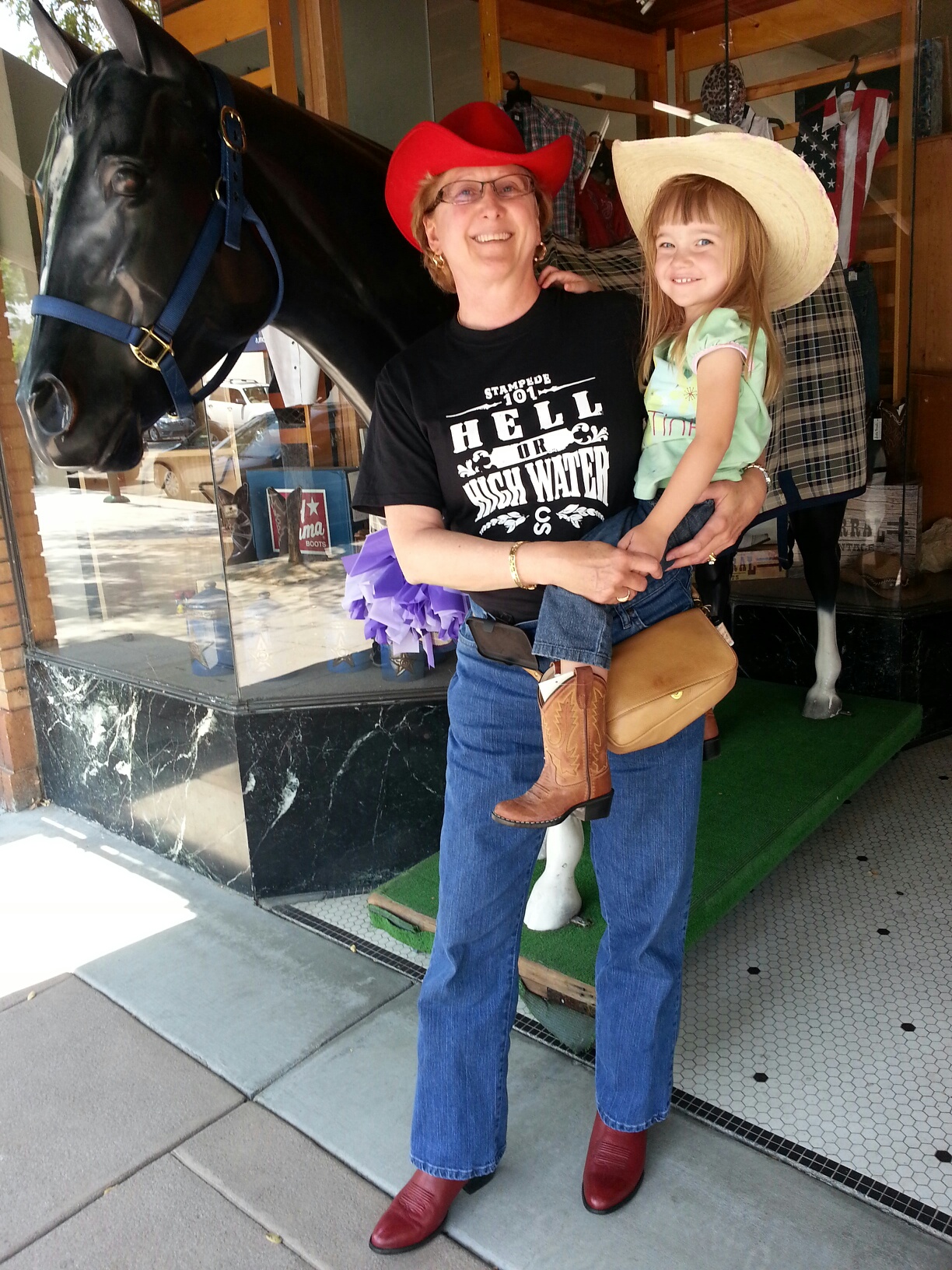
Many of my readers have had dealings with Marty. She processed orders for me in 2007 and 2008 and still occasionally gets involved with orders. One reader once called about an order and began by saying he “talked to my girl the other day.” I had to correct him. “That was no girl. That was my wife.” Another customer was very impressed by her treatment of him and suggested I give her a raise. Marty is the woman I met via “The System” which is decribed in detail in my book Succeeding. We just had our 38th anniversary.
Nowadays, my orders are processed by my son Mike. He is in the National Sarcasm Society of America, not Red Hats. Their crest bears the Latin inscription “E pluribus smart assimus.” Here is a photo of him and my wife at his 2011 graduation from the University of Arizona.
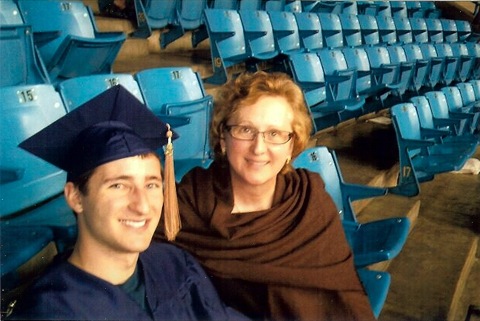
Lots of people have told my wife she looks like Meryl Streep, particularly in this photo. I don’t think so. Here is the Streep photo that most resembles this picture of Marty in terms of glasses and the wrap around their necks. You can juxtapose them in the screen by using two browser windows. I do not see much resemblance. Streep has narrower eyes, a thinner face and nose, more prominent cheek bones. She frequently wears red lipstick. Her recent photos look older than Marty. Streep is older—by two months. But I am not arguing. People have been telling her she looks like Streep since 1979 so I guess she must to others.
Happy Trails to you
Each day’s rodeo at the Calgary Stampede ended with the playing of a recording of Roy Rogers and Dale Evans singing Happy Trails. It choked me up the first day. They played it without irony because its lyrics represented their authentic feelings. In the US, if you hear that song, it is probably being played to make fun of the 1950s or Baby Boomers.
For younger readers, let me explain who Roy Rogers was. He was the “King of the Cowboys,” a singing cowboy. Dale Evans, the “Queen of the West,” was his wife on screen and off. But he was also the superman with a gun and his fists. In almost every episode of his TV show or movie, he would have to quick draw against a bad guy who was trying to kill him. Invariably, Roy would be faster but only shoot the gun out of the opponent’s hand—without even drawing blood!
He was the world’s nicest guy, 100% pure in habits, utterly modest, super kind, a perfect gentlemen, and natural leader without ever being bossy. Tall, handsome, apparently super athletic. He has three stars on the Hollywood walk of Fame (radio, motion pictures, and TV) and is the only person elected to the Country Music Hall of Fame twice (as a member of the Sons of the Pioneers and solo). He was one of the biggest stars in the world in the 1930s, 40s, and 50s. There was no daylight between Roy Rogers the actor/singer and Roy Rogers the person. Back then, the Hollywood kids heroes were expected not only to be role models, but perfect ones. And they were. I recall no scandals involving Roy or his imitators. It was a far simpler, infinitely more innocent time.
Unrealistic, you say? Yep. Nowhere near as realistic as the stuff today’s kids are raised on—like Grand Theft Auto.
I was only in Calgary for four days of the Stampede, but it inspired the thought that a place and time I thought disappeared 50 years ago is alive and well 125 miles north of the US in Alberta, Canada. (In the interest of full disclosure, my wife and I attended Mule Days in the beautiful Owens Valley in Bishop, CA on Memorial Day weekend in 2012 and I think they played Happy Trails there once during their mule rodeo. But that did not choke me up. They played it as sort of a cowboy novelty. When they play it at the Calgary Stampede, they are serious.)
I am not suggesting at all that Calgary is 50 years behind the times. They have cell phones and the Internet and all that. Rather, they seem able to pick and choose what they want to abandon and what they want to keep better than Americans.
Skirts and collared shirts
My wife commented that she did not recall the last time she saw such a high percentage of women wearing dresses or skirts—and this was at the Stampede which is sort of like a state fair. I then looked at the males and commented similarly that I did not recall the last time I saw so many males wearing collared shirts with the shirt tails tucked in. I always wear collared shirts with the shirt tails tucked in.
It is like there in that younger males did often have tee shirts that were not tucked in. But the percentages are different. Here almost all young men are dressed more casually and ugly with tank tops and gang-wannabe shorts. Their girls dress similarly. They would stand out negatively in Calgary. In Calgary, you see many young men wearing tee shirts and such, and many young women in shorts or pants, but also many young men wearing collared shirts with the tails tucked in and many young women in skirts. With middle-aged people there, virtually were dressed as they would have been in the early 1960s in the US—I do not recall any middle-aged people trying to pretend they were young with sleeveless shirts or tattoos or piercings like you see here often.
In all, a sight for sore eyes.
Behavior in crowds
I’ll give you some examples of the nicer-than-Americans observation. I was at a Stanford-Cal football game a few years ago. In the crush of people leaving, a 6'6" late 50s age guy behind me was pushing me driving me into the people in front of me who were not able to move any faster. I’m 5'11" and was about 64 then. I stepped aside and motioned for him to go ahead of me. He did then started kicking me. My son and college classmate who were with me stepped up and demanded to know what he was doing. His friends stepped up mortified and assured me, “He’s not like that.” I said, “Apparently he is.” He ran off disappearing into the crowd.
The students and graduates of Stanford and Cal fancy themselves higher forms of life than ordinary college grads—let alone mere Calgary Stampede attendees—because of very selective admission and graduation standards. Apparently not.
At the big final game at the U. of Arizona, which I attended because my son was a senior and an equipment manager and he and I were introduced to the crowd along with the other senior players and managers before the game, an Asian student was similarly pushing me as I was carrying food down the steps to my seat. There was no room to step aside because it was a two-way, narrow aisle. I turned around to tell him the pushing was not going to accomplish anything. He accused me of having “an attitude.” I did. I was considering sharing my Coke with him and his clothes then going back to get another. I decided that was likely to get me thrown out so I just stopped and stared at him. He backed off.
These sorts of belligerent, macho-man encounters are the rule rather than the exception in crowded events in the US. Not everyone behaves this way, but probably to one degree or another you see it or sense it repeatedly in each multi-hour event. And you sort of have no choice about it. When I worked at Crocker Bank in San Francisco, the MBA at the next desk had previously worked in Manhattan for BusinessWeek. He said in Manhattan, to walk on the sidewalk, you need to put your head down and walk forward as if you do not see the other people—“projecting a force field,” he called it. He discovered this when he noticed he was constantly walking in the gutter because everyone else was doing that to him. In other words, if a Calgarian went to Manhattan, or even to the higher tone Stanford-Cal or Arizona-Arizona State football games, where virtually everyone is a college student or grad, not a cowboy, the Calgarian would either walk in the gutter all the time or “when in Rome.”
It was nice to be out of Rome for three days.
At the Calgary Stampede, which was extremely crowded with mobs of cowboys and cowgirls in terms of dress—from boots to hats, every single such encounter resulted in the Calgarian man stepping back and gesturing with his hand for me to go ahead. They were not reacting to any American macho behavior on my part. They simply headed off each and every situation which, in the US, would have resulted in jostling, exchanges of glares, or maybe words.
Rodeo
I am not a cowboy or a rodeo fan. My wife is. She sent her high school years in Ethiopia. There was no American school, so she studied by correspondence school with the University of Nebraska. Plus she had two horses and rode them daily. So she was the impetus for our going to the Grand National Rodeo some years ago (Cow Palace in San Francisco) and the Mule Days and the Stampede. But I enjoyed the Mule Days and Stampede in spite of not being a fan. Indeed, after you watch the events multiple times, you start to appreciate the details. I have written about 18 books on coaching baseball and football so I watch events like a rodeo as a coach looking for the coachable techniques and the talent required stuff.
So if you are not a fan like me, I predict you will still enjoy the rodeo if you pay attention to the announcers and the events. Also, you may not realize it but each event involves a man or woman and an animal—horses, calves, bulls, and steers. At Calgary, they would tell you the background of the person and the animal they are riding or trying to take down. at the final bull riding event on the third day at the Stampede—I surmise bull riding is the main rodeo event—the announcer said the bull the cowboy was on was the top Bull of the Year for all of rodeo in the world or some such. That created an air of anticipation—and the bull did not disappoint. The biggest crowd noise of our three days was the reaction to that bull whose first movement was to explode straight up leaving the ground on all four hooves and reaching an amazing altitude. And nothing he did subsequently was any less spectacular. Tho cowboy in question stayed on the required eight seconds and violated no rules and won that day’s championship in large part because of the spectacular performance of the bull. They give points for each ride like ice skating in the Olympics.
In many cases, the animal simply outsmarts the human making them look foolish, like steers and calves who come out of the chute and simply come to a complete stop, because they know they are going to be roped or jumped on if they continue. Of course, that’s not good rodeo but a couple of them sprinkled in are funny to watch. For once, the underdog animal beat the human.
Junk food
The food trucks at the Stampede were more varied than any I have ever seen, but that may just be because I do not attend many state or county fairs and such. We enjoyed sampling new junk food and did not have time in three days to try as many as we wanted. I think our favorite was the hot, fresh, cinnamon sugar mini donuts. (I only gained 2.2 pounds during the three-week trip so no guff, please.)
Rodeo is 1 to 4PM daily. One two day, we then went to events available to us because we were hosted by a director—a president reception where the Hors d'oeuvres were so great that you could skip supper and a buffet dinner in the clubhouse for the officers of the Stampede. He also got us into a Cowboy Up competition which I had never heard of. Quite interesting. It was like an obstacle course for horse and rider—both men and women competing in the same competition.
And it included such unmacho events as getting the horse to stand still while you did very distracting things a short distance away from him or her. Another event was getting the horse to run through a bunch of plastic streamers sort of like a shower curtain that had been cut into fringe. The horse had to trust its rider that running through such was a good idea. In one case, the horse went through in one direction leading to an open area okay, but went through in the opposite direction later leading to a tight turn before a fence and ran right into the fence and fell down with the rider on top. Neither was hurt and they continued.
We were in a VIP section for that, too, which put us so close to the horses that you could reach out and touch them. Horses are magnificent animals, especially when they are running at full speed and turning as they were at this event. We the were taken to a chuck wagon race in the main stadium, only standing next to the track rather than in the stands as we were for the rodeo earlier. Now you’re looking at six horses running full speed from about five feet away. Very exciting.
Here is a photo we took while we were in the infield right next to the chuck wagon races. This is looking back up to the main stadium. The highest window you see is the press box from which we got to watch the night time stage show. As you can see looking at the crowd, if you don’t wear cowboy clothes, you look like some stick in the mud who refuses to get into the spirit of the Stampede.
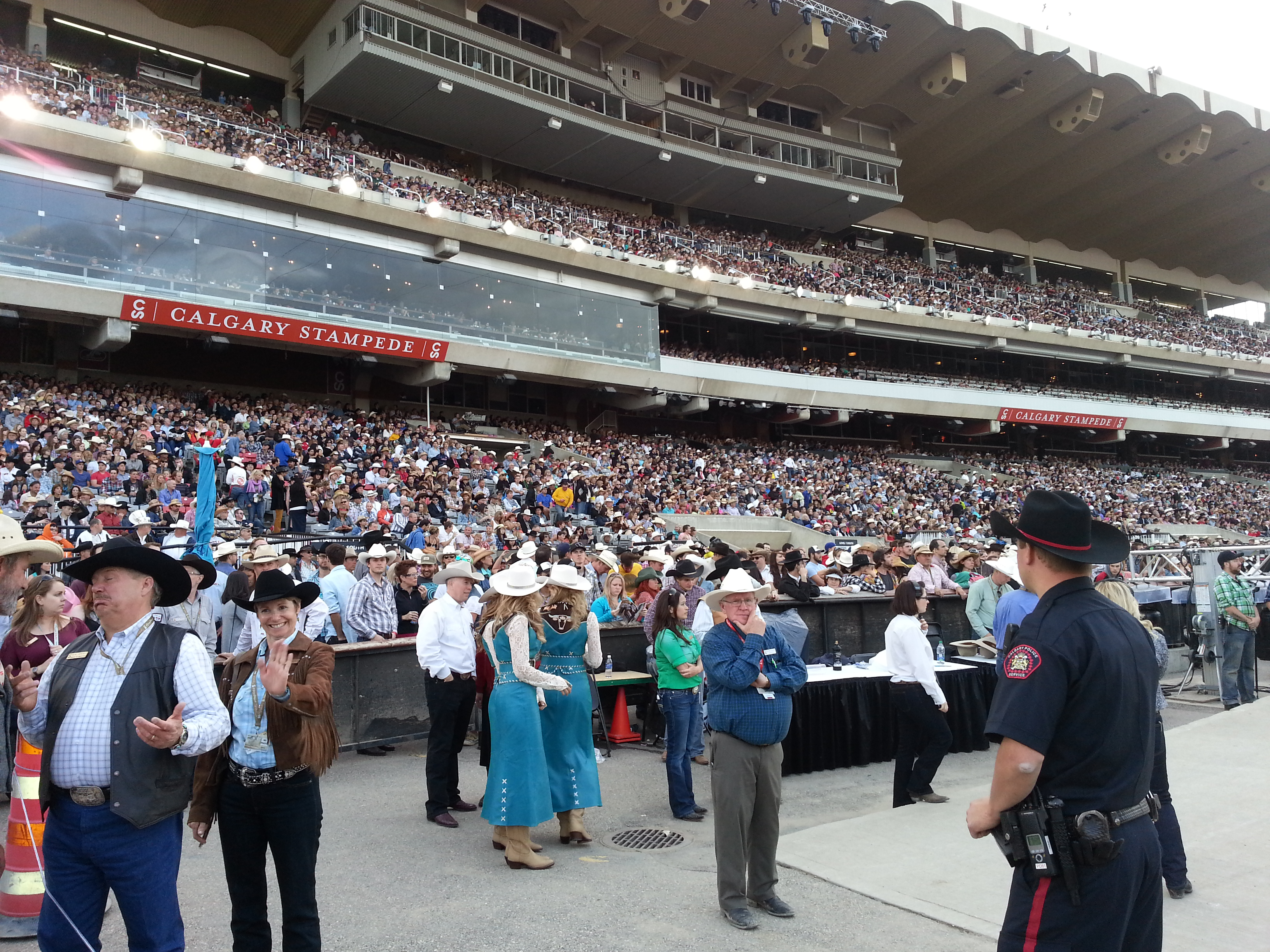
Understand that this is not a Canadian rodeo. Yes, it is in Canada, but on those dates it is apparently THE rodeo worldwide. The competitors were often introduced as prior world champs. Unlike Canadian Football, there is no artificial restriction on the number of American competitors. They have competitors from many countries. Americans seemed to win most of the competitions, but there was no bias other than the announcers emphasizing locals or Canadianness as they introduced each competitor. They seemed equally impressed with youth, constantly touting the young winners to the ladies because of all the money they had won. Okay, maybe some aspects of the 1950s are better abandoned.
Stage show
Finally, our host took us to the press box at the top of the stadium for the evening show. This was totally unexpected to us. I don’t know how to describe it. Basically, Southern Alberta’s got talent, plus they import some from other areas. They had what is called a cover band of KISS. I did not know such thing existed. Could have fooled us. The Calgary Philharmonic musicians were worked into parts of the show and they were magnificent. Ditto the Calgary Ballet. And a group called the Young Canadians. This is apparently a one-year Young Canadians School of Performing Arts which is like the famous NYC high school that was featured in the movie and TV series Fame. The show also had Cirque de Soleil and fantastic, huge, flying, stainless steel moving horse sculptures. Was it a rodeo theme? Not much, just a spectacular, fast moving, variety show of singing, dancing, musicians, acrobats—and it was really good. No world-class talent in terms of reputation, but a world-class show by dint of the effort and direction. Apparently, they do the same show every night. We would not have attended because it did not sound worth it at the web site. Shame on us. We had a sense watching it that no where else on earth were people enjoying any show as much as we were at that moment.
The show stage is built underground and rises up from under where the rodeo events just took place hours before every night, but not in 2013. The flood destroyed all that 15 days before the Stampede started. They had to build on short notice and from scratch a totally new and very elaborate stage which was on wheels and moved in front of the stands each night. Had they not told us, we would not have known it was any sort of makeshift deal.
Here is a photo which does not do the stage show justice. Much of what you see in the photo is fireworks going off and shooting flames. There is also music and crowd noise and more. In the middle of the stage, you can make out a man in a black tux sitting at a white grand piano and singing. That man and his piano are suspended from wires above the stage and moving. And he is not the only flying singer in the photo. You have to be there to experience how great the show is.

So, should readers who are not in the area travel to Mule Days in Bishop, CA to see it. Yeah, if you are in Arizona, Nevada, or Northern California. Come from farther away if you are interested in mules.
Should non-Calgary readers come to the Calgary Stampede. Yes. From how far away? Planet Earth. Our host said it was rated one of the top five or ten festivals on earth by someone. We could not find that just Googling that title, but I would be hard pressed to argue the point. We expected to have a nice time and enjoy the Stampede but it far exceeded our expectations and we were blown away by much of it. Of course, this has been a year when our Harvard Business School ties got us unexpected insider treatment in New Zealand, then Sydney, then Calgary. Don’t know if it is as great if you just show up as Joe Tourist—or Shane Tourist at the Stampede.
If you go to the Stampede. Try to attend each event at least once: afternoon rodeo, Cowboy Up, chuck wagon races, and evening show. And try some of the ridiculous junk food. They also had big-name, country-western entertainers there in a separate quonset hut sort of deal but the line was always daunting.
Wear understated cowboy clothes. That’s part of the fun and almost antagonistic if you don’t. I did not know I was supposed to at Mule Days and felt a bit uncomfortable and conspicuous as a result.
Revolving restaurant
We always go to the revolving restaurant in a new city if they have one. I recommend them all except the one in Calgary. My wife liked the food, but I most definitely did not. Visit their observation deck only. They had an excuse. The neighborhood had been evacuated because of the flood and the night we were there—July 4th—was only their second night open. But on the 5th, we went to Ruth’s Criss, which is on the second floor of the same tower, and they experienced the same flood but still managed to do their normal great job and offer a full menu.
Lake Louise
Here is a Facebook post I put up while traveling on July 9th:
The view here at The Fairmont Chateau Lake Louise is so spectacular it woke me up. That was a first. Yeah, I took some photos but I don't know how to put them on Facebook or anywhere else. Google my hotel. They have better photos.
.
When I went to sleep, I only closed the sheer curtains because they have no a/c here and it was warm inside the room, albeit not outside. At around 5:30, I was awakened by a bright light. It was the sun on a cloudless day—for a change here in Canada—hitting the white glaciers at the other end of the Lake Louise Valley. Spectacular! It was so bright it came through the sheer curtains and my closed eyelids.
Here is a photo, taken by my wife with her cell phone so I should not have been so fast to say the hotel had better pictures at their web site, from our room in the Fairmount Chateau Lake Louise:
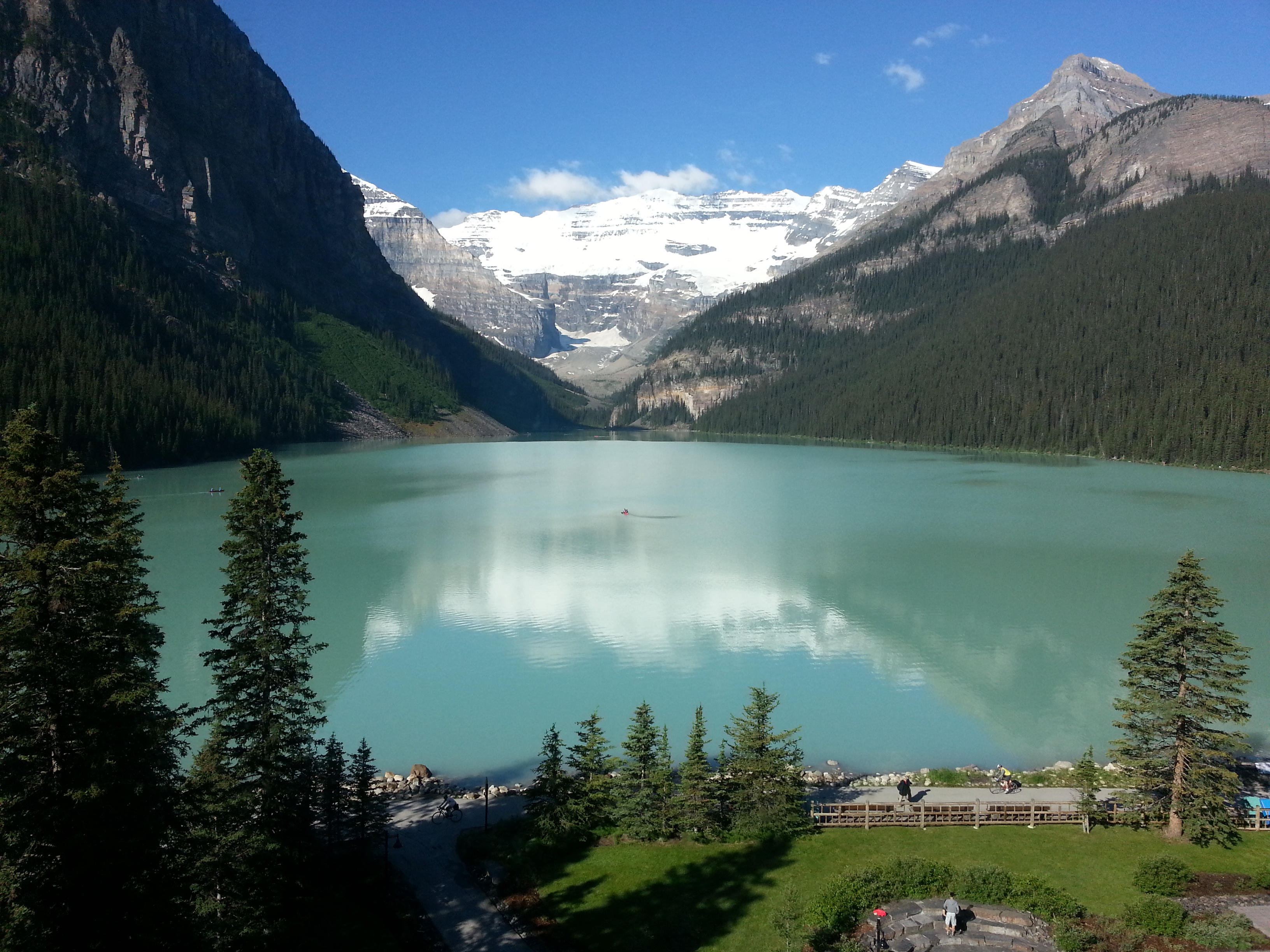
The speck in the middle of the lake is a red rental canoe—reportedly a long tradition at the Chateau. You can see another one between the two trees on the left. We did not rent a canoe. Although it was July 9th, that is near-ice water. You can see the glaciers that are the source of the lake’s water in the background. What you cannot see is the rather fast-moving outlet of the Lake around to the left of the photo. This is sort of a wide spot in a river, not a stagnant pond. Those glaciers are melting and the water is running through this Lake to the Bow River that flooded Calgary downstream.
Reserving a room here that does NOT have a view of the lake is prima facie evidence of terminal stupidity. If you are that eager to save money don't come here to begin with. We chose this Farimont instead of the not very far away and more famous Banff Springs Fairmont. That hotel is spectacular to look at, but its rooms do not have a view of the hotel, or Lake Louise. Like the Hotel Del Coronado in San Diego. At Banff, the view OF the hotel is better than the view FROM it.
Grizzly Bears
On July 9th, we also went to a Ski Resort across the highway from Lake Louise Village. We were just there to ride a ski lift up to the top of Whitehorn Mountain for the view. My wife’s big goal was to see some grizzly bears.
Mission accomplished. Below is the photo she took from the chair lift of two bears grazing below us. As she was stretching and contorting to try to get a photo, I said, “If you drop that cell phone, I am NOT walking back up here to get it!”
Those are real, wild grizzly bears and the only thing keeping them from killing us was our being about 25 feet above ground dangling from a cable. The two ends of the chair lift are apparently protected from grizzly bears by electric fences, which we saw. In winter, the ground you are looking at in the photo is full of skiers. I’m guessing that the grizzlies do not bother the skiers in winter because they are hibernating. These are the Canadian Rocky Mountains which is some serious wildeness compared to what Americans are used to in the lower 48.
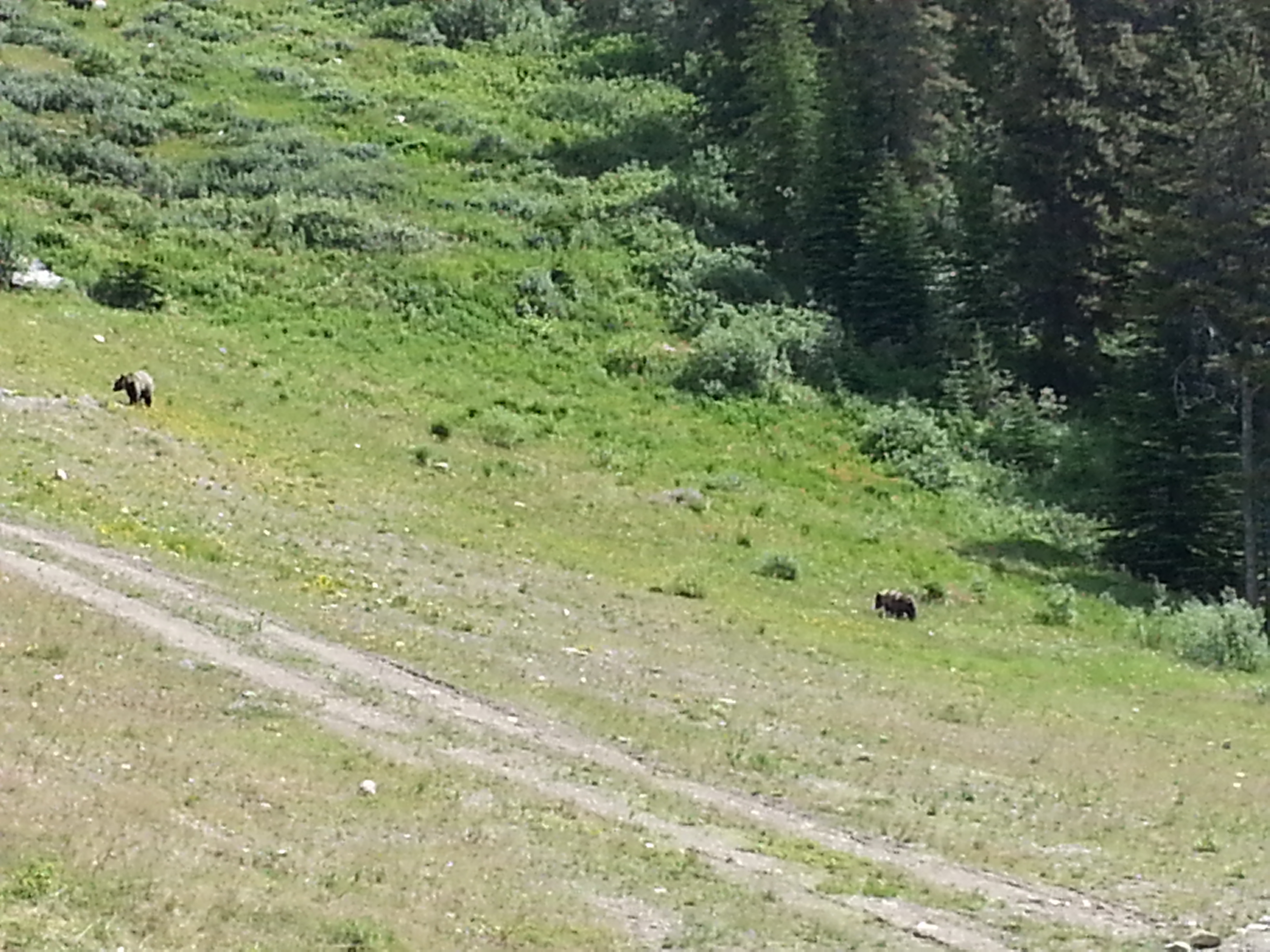
John T. Reed